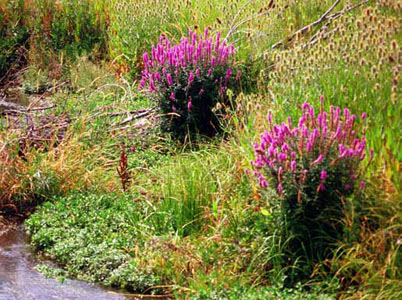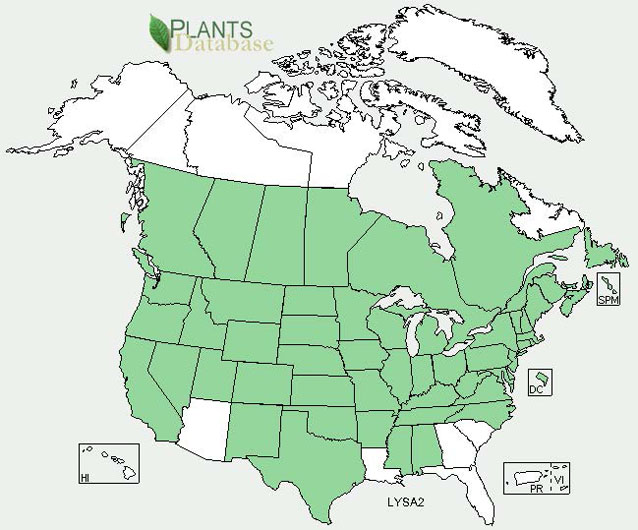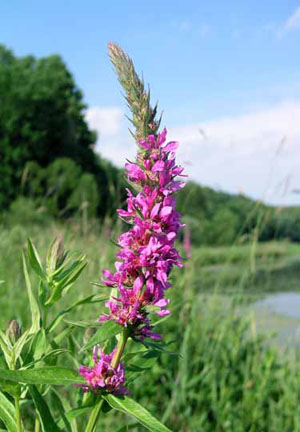Lythraceae (Loosestrife family)
At a Glance

© Steve Dewey / Utah State University
- Perennial
- Mature plants grow many stems in a clump up to five feet in diameter. Stems are usually two to six feet tall.
- Leaves opposite or whorled with lightly heart-shaped bases
- Magenta flowers occur in long spikes at the ends of the stems.
- Fruit is a capsule with many tiny seeds inside.
Habitat and Ecology
Native to Eurasia, purple loosestrife (Lythrum salicaria) now occurs in almost every state of the US. It was introduced to the east coast in the early 1800s, possibly as seeds in ship’s ballast or as an ornamental. Now the highest concentrations of the plant occur in the formerly glaciated wetlands in the Northeast. In the West, purple loosestrife invades irrigation projects. In all areas of the country, purple loosestrife also tends to occur in wetlands, ditches, and disturbed wet areas. Although it grows best in soils with high organic content, it tolerates a wide range of soils. However, it requires open, moist, and bare substrate for initial establishment. After establishing, purple loosestrife populations tend to remain at low numbers until optimal conditions allow the population to dramatically expand. The dense colonies that result can displace native vegetation and wildlife.

USDA
Description
Purple loosestrife is an erect perennial herb that usually grows two to six feet tall. A mature plant can develop into a large clump of stems up to five feet in diameter. Each stem is four- to six-sided. The root system consists of a very thick and hard taproot, and spreading lateral roots. Seedlings that germinate in the spring grow rapidly and produce a floral spike the first year. The seeds, which are very light, are mainly dispersed by wind, water, and mud. Although purple loosestrife reproduces primarily by seed, stem fragments are able to develop roots under favorable conditions. During the cool season, purple loosestrife dies back, resprouting from the woody crown in the spring.

© Linda Wilson / University of Idaho
Leaves
The leaves are narrow and long—about two to six inches in length. The bases are slightly heart-shaped. The leaves occur in opposite pairs or whorls that attach closely to the stem.
Flowers and Fruits
The magenta flowers occur in long spikes at the end of the stems. Along the stem, one to two flowers attach closely to the stem above each pair of leaves or bracts. Each flower has four to six, occasionally seven, petals. The petals occur above a cylindrical tube.
The fruit is a capsule, or a fruit composed of more than one carpel that opens at maturity. The dark brown capsule is surrounded by the persistent tube of the flower. Each capsule has many reddish-brown, tiny seeds.
Etymology
Lyth’rum comes from the Greek word lythron, which means “blood”. The word refers to either the color of the flowers or to its reputed ability to help stop bleeding. Salicar’ia means “resembling a willow”.
Similar Species
From a distance, purple loosestrife may be confused with Epilobium angustifolium, Verbena hastata, Teucrium canadense, or Liatris spp. Up close, purple loosestrife is easily distinguished from these plants.
Control Methods
Possible control methods are explained at these websites:
References
Bender, J. 1987. Lythrum salicaria in Element Stewardship Abstracts. The Nature Conservancy, Arlington, VA.
California Department of Food and Agriculture. No date. Purple loosestrife in Encycloweedia. Available at https://www.cdfa.ca.gov/plant/ipc/encycloweedia/weedinfo/lythrum.htm (accessed 9 April 2010).
Charters, M. L. 2009. California plant names: Latin and Greek meanings and derivations. Available at http://www.calflora.net/botanicalnames (accessed 9 April 2010).
Munger, G. T. 2002. Lythrum salicaria in Fire Effects Information System. US Department of Agriculture, Forest Service, Rocky Mountain Research Station, Fire Sciences Laboratory. Available at http://www.feis-crs.org/feis/ (accessed 9 April 2010).
Prepared by Kelly Reeves, Southern Colorado Plateau Network Inventory and Monitoring Program, 2010.
Last updated: June 28, 2016
